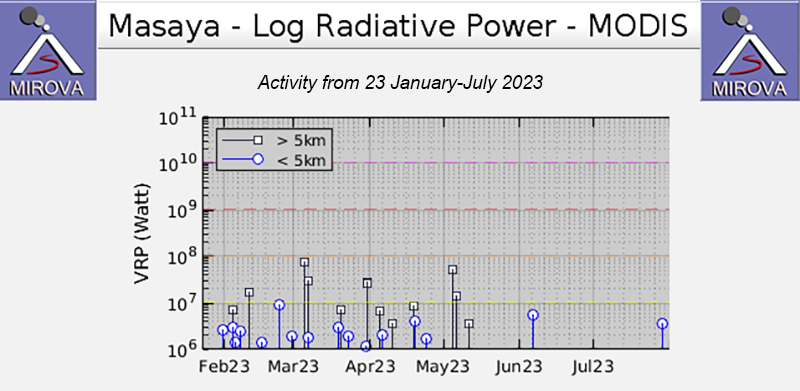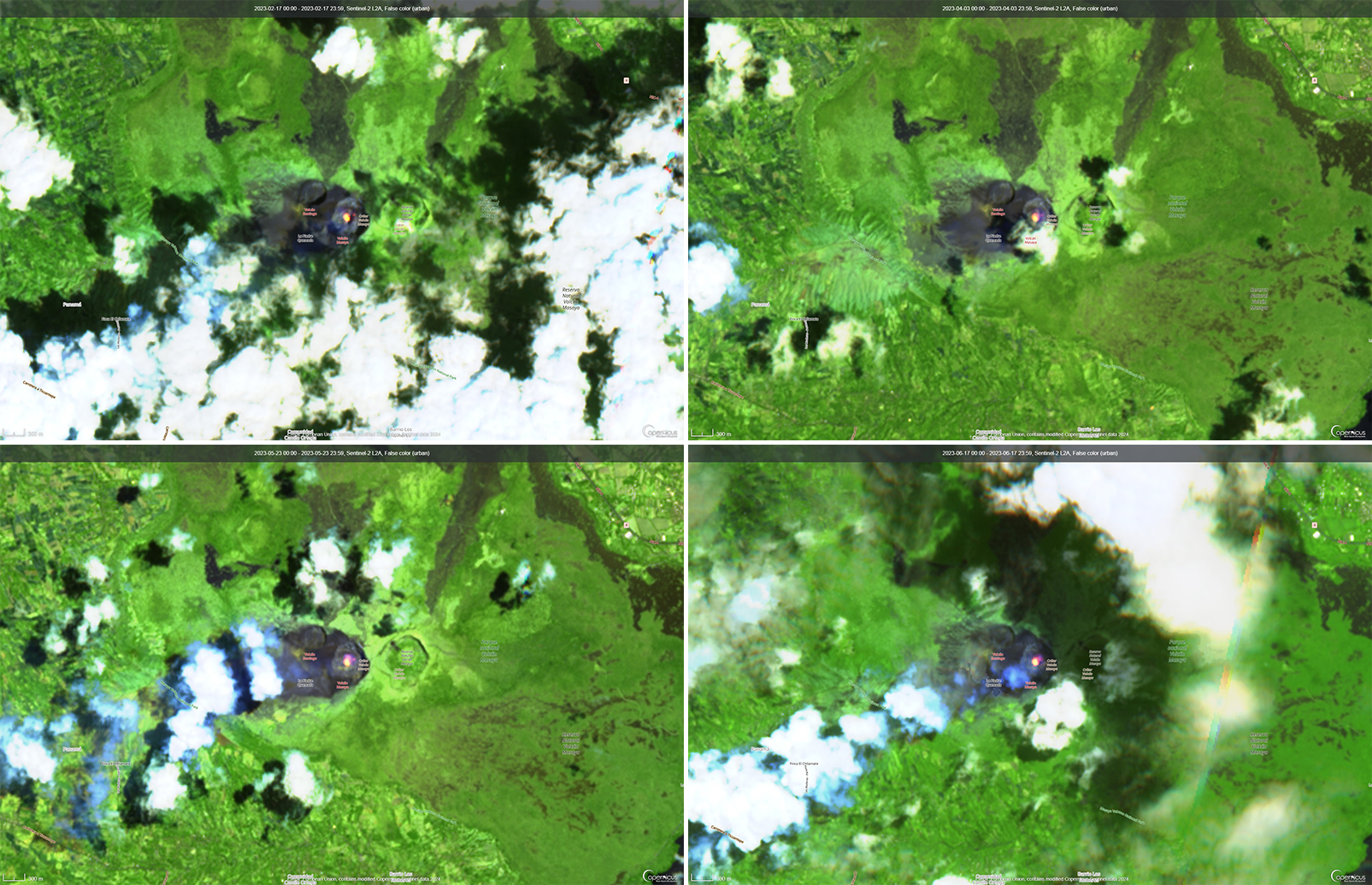Report on Masaya (Nicaragua) — August 2023
Bulletin of the Global Volcanism Network, vol. 48, no. 8 (August 2023)
Managing Editor: Benjamin Andrews.
Edited by Kadie L. Bennis.
Masaya (Nicaragua) Thermal anomalies in the summit crater during February-July 2023
Please cite this report as:
Global Volcanism Program, 2023. Report on Masaya (Nicaragua) (Bennis, K.L., and Andrews, B., eds.). Bulletin of the Global Volcanism Network, 48:8. Smithsonian Institution.
Masaya
Nicaragua
11.9844°N, 86.1688°W; summit elev. 594 m
All times are local (unless otherwise noted)
Masaya, located about 20 km SE of Managua, the capital Nicaragua, is a broad, 6 x 11 km caldera with steep-sided walls up to 300 m high. The caldera is filled on its NW end by more than a dozen vents that erupted along a circular, 4-km-diameter fracture system. Eruptions have originated from the Nindirí and Masaya cones, which were constructed at the southern end of the fracture system and contain multiple summit craters, including the currently active Santiago crater. The Santiago crater contains a small lava lake that emits weak gas-and-steam plumes. The current eruption period began in October 2015 and more recently has been characterized by thermal activity in the summit crater (BGVN 48:03). This report covers similar activity from February through July 2023, consisting of continuing thermal activity and sulfur dioxide emissions, according to monthly reports from Instituto Nicaragüense de Estudios Territoriales (INETER) and satellite data.
Thermal activity has remained relatively consistent, according to a MIROVA (Middle InfraRed Observation of Volcanic Activity) analysis of MODIS satellite data, which showed occasional low-power thermal anomalies during the reporting period. There were six anomalies were detected during February, four during March, three during April, one during early June, and one during late July (figure 109). Infrared satellite imagery showed occasional hotspots in the Santiago crater’s lava lake throughout the reporting period (figure 110). The TROPOMI instrument on the Sentinel-5P satellite detected weak and small sulfur dioxide plumes that drifted generally W and SW on 8-9 February, 3-4, 13, and 18 March, 25 and 30 April, 11-12 May, 1-2 and 11 June, and 3 July.
Activity was relatively low throughout the reporting period. Seismic tremor was at 60 RSAM units during February and March. On 10 February FLIR temperature of the lava lake was measured from Santiago crater, recording values of 290°C, which was within the typical range of 200-500°C. INETER noted that the level of the lava lake had decreased compared to previous observations made during October 2022. On 15 March gas measurements were made with a Mobile DOAS technique, showing average sulfur dioxide values of 1,448 tons/day (t/d); the previous date that measurements were taken was on 14 November 2022 with a value of 1,222 t/d. On 25 April sulfur dioxide measurements decreased slightly to an average of 1,042 t/d. Temperature values of the lava lake from Santiago crater were 254°C on 26 April.
Seismic tremor was at 50 RSAM units during May and consisted of one volcano-tectonic (VT) event and 347 low-frequency (LF) events. On 5 May INETER recorded a temperature of the lava lake from Santiago crater of 270°C and reported that the level of the lava lake was lower compared to previous observations made in April. Sulfur dioxide measurements taken on 15 May were 1,438 t/d. During June and July, seismic tremor was maintained at 50 RSAM units and included one VT event and 221 LP-type events during June, and three LP-type events during July. On 28 June measurements of the lava lake had increased slightly to 315°C and the level of the lava lake continued to decrease. The average values of released sulfur dioxide emissions were 1,056 t/d on 19 June and 1,012 t/d on 14 July.
Geological Summary. Masaya volcano in Nicaragua has erupted frequently since the time of the Spanish Conquistadors, when an active lava lake prompted attempts to extract the volcano's molten "gold" until it was found to be basalt rock upon cooling. It lies within the massive Pleistocene Las Sierras caldera and is itself a broad, 6 x 11 km basaltic caldera with steep-sided walls up to 300 m high. The caldera is filled on its NW end by more than a dozen vents that erupted along a circular, 4-km-diameter fracture system. The Nindirí and Masaya cones, the source of observed eruptions, were constructed at the southern end of the fracture system and contain multiple summit craters, including the currently active Santiago crater. A major basaltic Plinian tephra erupted from Masaya about 6,500 years ago. Recent lava flows cover much of the caldera floor and there is a lake at the far eastern end. A lava flow from the 1670 eruption overtopped the north caldera rim. Periods of long-term vigorous gas emission at roughly quarter-century intervals have caused health hazards and crop damage.
Information Contacts: Instituto Nicaragüense de Estudios Territoriales (INETER), Apartado Postal 2110, Managua, Nicaragua (URL: http://www.ineter.gob.ni/); MIROVA (Middle InfraRed Observation of Volcanic Activity), a collaborative project between the Universities of Turin and Florence (Italy) supported by the Centre for Volcanic Risk of the Italian Civil Protection Department (URL: http://www.mirovaweb.it/); NASA Global Sulfur Dioxide Monitoring Page, Atmospheric Chemistry and Dynamics Laboratory, NASA Goddard Space Flight Center (NASA/GSFC), 8800 Greenbelt Road, Goddard, Maryland, USA (URL: https://so2.gsfc.nasa.gov/); Copernicus Browser, Copernicus Data Space Ecosystem, European Space Agency (URL: https://dataspace.copernicus.eu/browser/).



